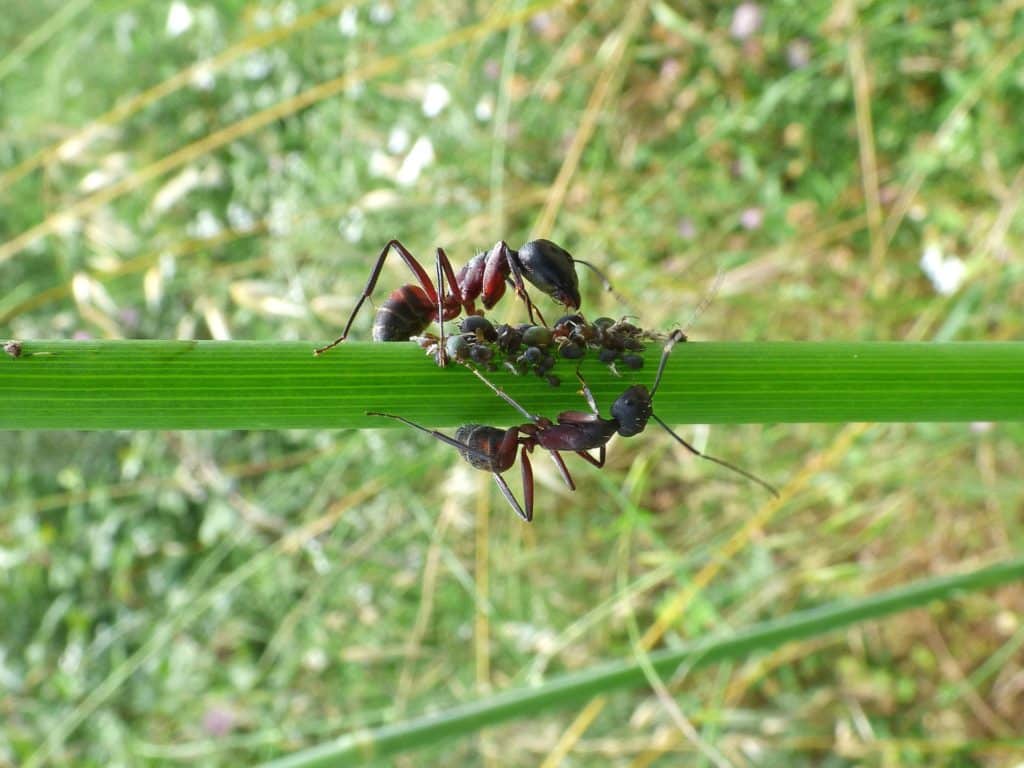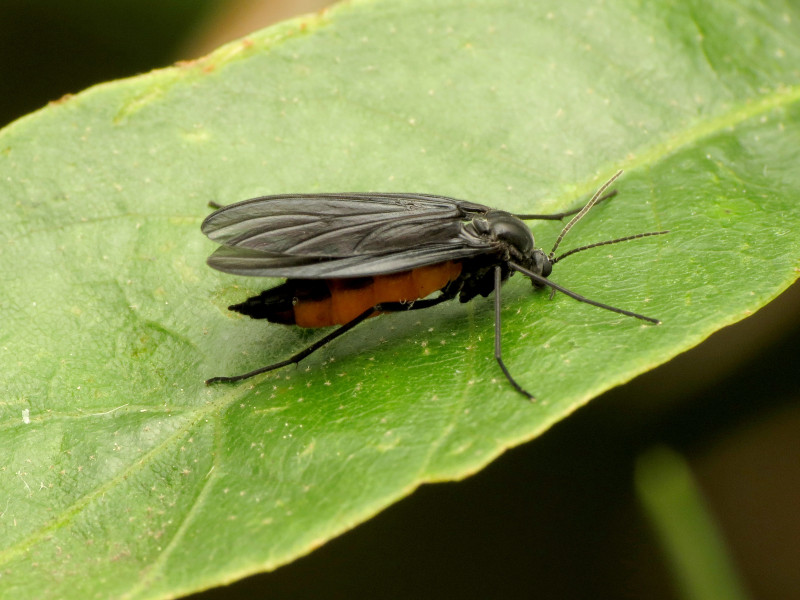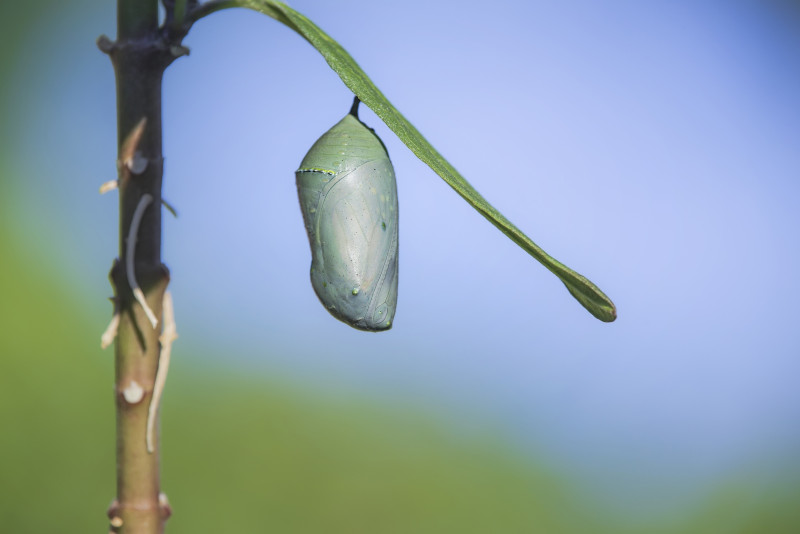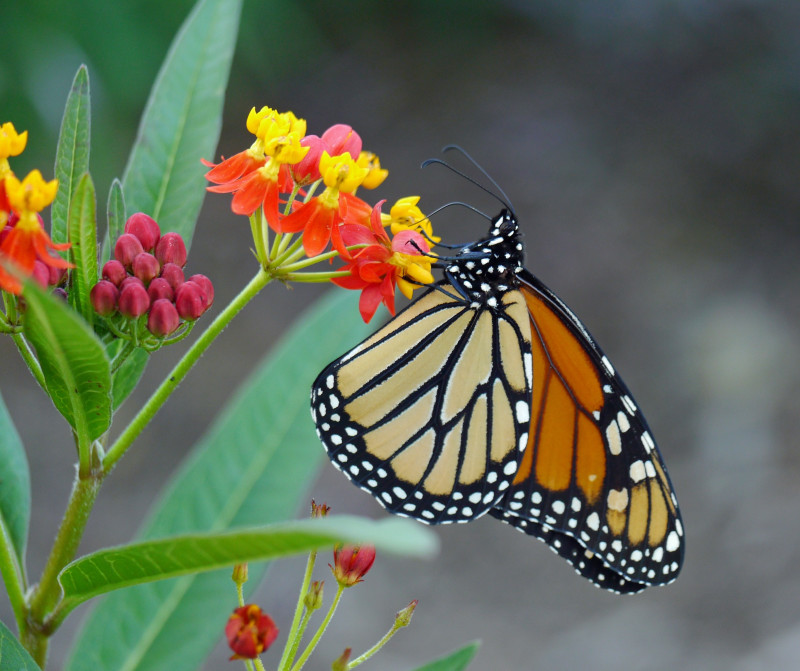Their ‘straw’ goes with them
The butterflies circulating your flowers are sipping nectar. They do it through a “proboscis,” a tube designed for sucking liquids. When not being used, these insects keep their proboscis rolled up (as shown in the photo above). Where bees feed themselves and take nectar back to the hive, the butterflies feed only themselves.
Once a butterfly lays her eggs, they’re on their own, as will the tiny caterpillars emerge from them. But their mother wants to give them the best start with the right plant: one her caterpillars can use for food when they hatch. The parsley plants in your garden are precisely what a Black Swallowtail butterfly will seek for her eggs. Tomato or lilac plants won’t do; she insists on a member of the carrot family.
Many butterfly caterpillars have no defenses at all, save for green or brown coloration that helps them blend into their surroundings. However, Black Swallowtail caterpillars have a defense in the form of a very offensive odor they can emit to help repel predators. It comes from a V-shaped organ located behind their head, ordinarily kept out of sight. To see the organ, gently touch the caterpillar with your finger. It’s harmless and will feel dry to the touch. It’ll react by quickly contorting its body—you can feel its musculature. Like a Jack-in-the-box, you’ll immediately see the bright-orange V pop up and smell the strong odor. In a few moments, if there’s no further provocation, it’ll relax, return to its munching, and the smell will dissipate. It’ll need lots of it on its way to becoming a butterfly—this smelly defense won’t deter all predators, and life for this caterpillar (and most others) is fraught with danger.
Farming the insect way
Looking more closely at your plants, do you see aphids? These tiny, pear-shaped, mostly all-female insects feed in colonies and suck the nutritious plant juices that are needed by young shoots and twigs. Aphids can be very destructive to plants if there’s a substantial infestation. However, they’re a favorite prey of ladybugs, Green Lacewings, hoverflies, and others, so that would seem to be the end of their story.
But, as it happens, aphids have friends in high places: Many ant species prize aphids as “pets.” Aphids excrete a sugary waste product called honeydew that some ant species like so well they herd and keep aphids “stabled.” At night, the aphids are kept in long chambers dug along the stalk of a plant, and by day, they’re carried to their feeding ground, where ant patrols guard them. Precious “livestock,” indeed!
The aphid herds don’t try to escape. They have fresh plant food and a SWAT team at hand. It’s a pretty easy life for these lucky ones. Study the colony of aphids on your plant, and you might see ants “milking” them—that is, lapping up honeydew even as it’s being excreted. Despite their ant protectors, a healthy wildlife habitat has more than enough predators to keep the aphid population under control.
Searching for milkweed
We all know the story of everybody’s favorite butterfly, the valiant Monarch, who flies thousands of miles to and from resting spots in Mexico and southern California. Many people don’t realize that, along the way, females lay eggs. Have you planted milkweed? They need them to lay their eggs on.
A female who begins the trip north in spring is the same one who migrated south last fall. She is now seven or eight months old and has flown thousands of miles fighting wind currents and extreme weather. She’s had to search hard to find milkweed plants, and when she does, she lays eggs. Many of the protective orange-and-black scales on her wings have probably rubbed off, and there may even be an edge missing, or little tears may be making it harder for her to fly. She’s exhausted and weak. About halfway back to her northern range, her body gives out, and she dies. But her story doesn’t end with her death: Her children and even some of her children’s children will continue to press northward, some up into Canada.
In the fall, the last generation of this year’s Monarchs will make the long flight south to their winter home. By day they fly, frequently riding the wind. Like us, they need to stop for meals, and so, incidentally, give us the opportunity to watch them in their prime, at their showiest best. When you begin seeing Monarchs regularly during the day, look up, up past the height of your tallest trees, maybe 100 feet (30 m) into the sky. With luck, you’ll see groups of hundreds, even thousands, as they glide southward. It’s a sight you won’t soon forget. At night, they’ll rest, perhaps in your yard. Look for a large group roosting in trees, especially pine, fur, and cedar.
What else is a mother to do?
Bringing your eyes back down to a lower level—at, say, bare-arm level, where mosquitoes love to alight—do you see one? Hopefully, you’ll see her before she sees you. In truth, mosquitoes don’t see us; they have very poor eyesight and can’t distinguish us from a tree. That would seem to be a good thing, but it doesn’t really matter. They have other ways of finding you: They can sense the carbon dioxide you’re exhaling from 100 feet (30 m) away, and they’re attracted to it. If you could somehow hold your breath indefinitely, the mosquito would move on, IF it wasn’t also the case that she’s attracted to your body heat. And she can sense that from 10 feet (3 m) away.
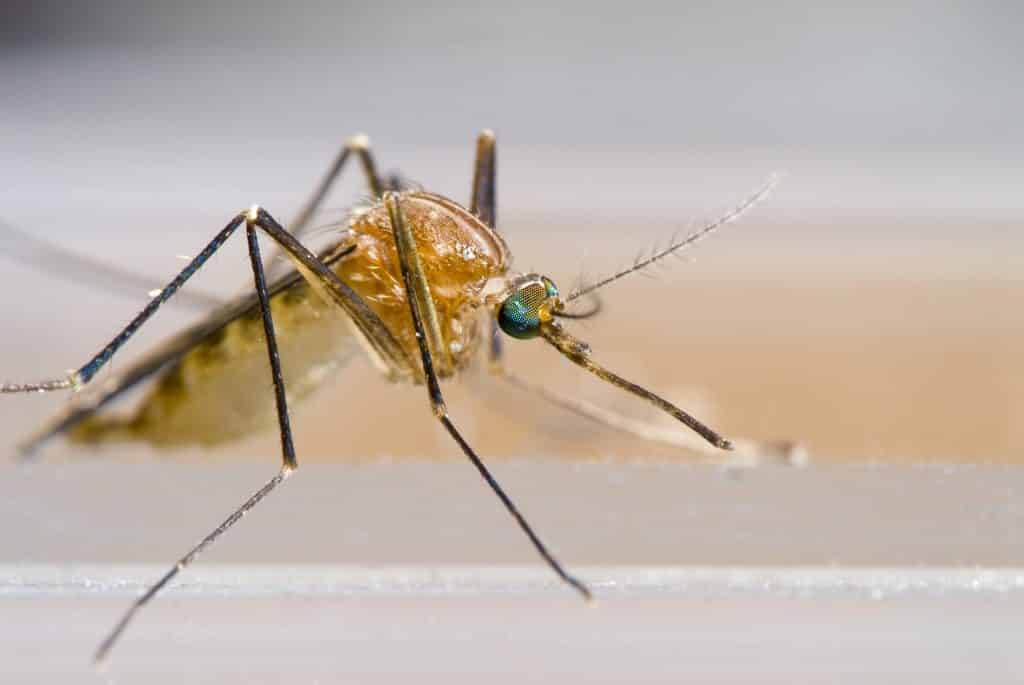
Hidden within this mosquito’s straw-like proboscis is a tube with a very sharp tip designed for piercing skin (© doug4537 / iStock)
Does it seem they were designed to pick on us? It’s one of nature’s little jokes that the female mosquito needs blood, and we have plenty of it. It isn’t personal—she’s just as happy with the blood of a dog or a deer. Mosquitos are happiest of all with a bird’s blood, but if a human happens to be the nearest blood bank, they’ll lower their standards and take us!
It’s the protein in blood they want. Male mosquitoes live on nectar, unlike females, who need concentrated protein to produce eggs. That itchy, red, swollen, annoying bite you just got? It’s merely a mom doing her job!
It’s easy to make light of mosquitoes, but, of course, their harm isn’t always limited to an angry red bump on the arm. They can carry diseases. In the U.S., currently most notable is the sometimes deadly West Nile virus. Elsewhere in the world, mosquito-delivered malaria kills more than a million people every year, most of them children.
Can anything good be said about mosquitoes? It would seem not. At least not from a human point of view. But nature doesn’t waste anything, and mosquitoes do serve some beneficial purposes. Males include aphid honeydew in their diet, thereby cleaning plant surfaces of the leftover sticky goo not consumed by ants. They pollinate flowers. A Utah entomologist, Lewis Nielsen, collected mosquitoes and identified pollen grains from more than thirty different plant species on their bodies and believes they’re more important pollinators than credited. And finally, mosquitoes are food for bats, fish, frogs, toads, turtles, birds, and dragonflies, which feed heavily on them.
Introduction to insects
All about ants
Monarch Butterfly lifecycle


